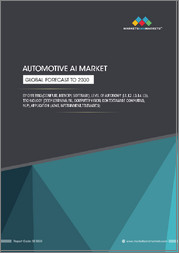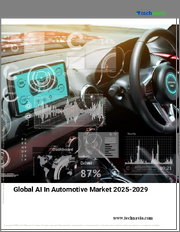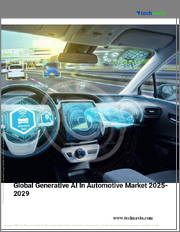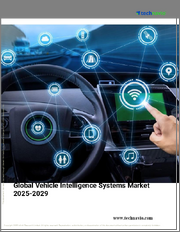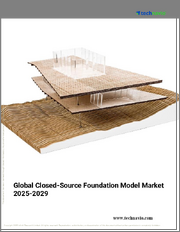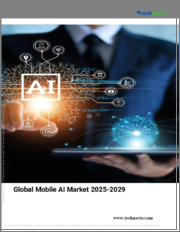
|
시장보고서
상품코드
1453674
자동차용 AI 시장 평가 : 제공, 프로세스, 기술, 용도, 컴포넌트, 차량 유형, 지역별 기회 및 예측(2017-2031년)Automotive Artificial Intelligence Market Assessment, By Offering, By Process, By Technology, By Application, By Component, By Vehicle Type By Region, Opportunities and Forecast, 2017-2031F |
||||||
세계 자동차용 AI 시장 규모는 2023년 30억 2,000만 달러에서 2024년부터 2031년까지 예측 기간 동안 20.67%의 CAGR을 기록하며 2031년에는 135억 8,000만 달러 규모로 성장할 것으로 예측됩니다.
고객 경험 향상에 대한 추가적 활용에 대한 관심이 확대되면서 이 시장의 성장을 촉진하고 있습니다. 또한, 자율주행차, 음성 제어, 첨단 안전 기능 등의 개념도 시장 성장을 촉진할 것으로 예상됩니다. 또한, AI를 인포테인먼트 시스템에 통합함으로써 최종사용자 경험에 편리함을 더할 수 있습니다. AI는 제조 현장의 확장에 따라 제조 속도를 높이고 인적 오류를 줄이기 위해 AI를 채택하고 있습니다.
AI 도입을 촉진하는 안전 역학 개선:
장거리 센서, 카메라 및 기타 구성요소는 중앙 인포테인먼트 시스템과 통합되어 차량 내에서 실시간 모니터링을 제공하며, AI는 자율주행차와 떼려야 뗄 수 없는 관계로 승객, 운전자, 자동차 제조업체를 포함한 모든 사람에게 편안함을 제공합니다. 자율주행차의 음성 인식 및 제어 장치는 자연어 처리(NLP)와 머신러닝(ML) 등의 AI 기술로 구동됩니다. 자동차 개발의 각 단계에서 AI의 역할 외에도, AI는 경로 계획 및 내비게이션 지원도 제공합니다. 여기에는 경로를 직접적으로 최적화하기 위한 위치 파악, 인지, 충돌 회피 등이 포함됩니다.
커넥티드카 기술 및 예지보전이 시장 성장을 촉진:
진화하는 커넥티드카 기술과 생성 AI의 통합은 서로를 보완하고 자동차를 지원하며, 5G 배포를 통한 IoT의 구조는 지속적인 인터넷 스트림에 대한 액세스를 통해 차량 통신 시스템 및 기타 온라인 서비스에 대한 액세스를 가능하게합니다. 여기에는 차량 대 차량(V2V), 차량 대 차량(V2I), 차량 대 차량(V2X)이 포함되며, AI는 인터넷 연결과 앱 대 차량 연결을 통해 발전하고 있습니다.
시장을 주도하는 정부의 지원:
세계 각국 정부는 각 분야의 혁신과 실험을 추구하고 새로운 기술 통합을 위해 보조금과 투자를 제공하고 있으며, AI는 이미 교통 카메라와의 통합을 통해 교통 규칙을 시행하는 데 활용되고 있습니다. 정부는 기술 대기업과 협력하여 새로운 기술을 개발하고 있습니다. 또한, 전기차 보급 촉진은 AI에 대한 수요를 가속화하고 있으며, 정부는 자동차 제조업체의 제조 공정을 지원하고 있습니다.
세계 자동차용 인공지능 시장을 조사했으며, 시장 정의와 개요, 시장 규모 추정 및 예측, 각종 부문별·지역별 상세 분석, 산업 구조, 시장 성장에 영향을 미치는 요인 분석, 사례 연구, 경쟁 상황, 주요 기업 개요 등의 정보를 정리하여 전해드립니다.
목차
제1장 조사 방법
제2장 프로젝트 범위와 정의
제3장 주요 요약
제4장 고객의 소리
- 제품과 시장 인텔리전스
- 브랜드 인지도 모드
- 구입 결정에서 고려되는 요소
- 프라이버시와 안전 규제에 관한 고려사항
제5장 세계의 자동차용 AI 시장 전망
- 시장 규모와 예측
- 제공별
- 하드웨어
- 소프트웨어
- 프로세스별
- 신호 인식
- 이미지 인식
- 데이터 마이닝
- 기술별
- 딥러닝
- 머신러닝
- 상황 인식 컴퓨팅
- 컴퓨터 비전
- 자연어 처리
- 기타
- 용도별
- 휴먼 머신 인터페이스
- 반자율주행
- 자율주행
- 기타
- 컴포넌트별
- 그래픽스 프로세싱 유닛(GPU)
- 마이크로프로세서(ASIC를 포함)
- 이미지 센서
- 필드 프로그래머블 게이트 어레이(FPGA)
- 기타
- 차종별
- 승용차
- 상용차
- 지역별
- 북미
- 유럽
- 아시아태평양
- 남미
- 중동 및 아프리카
- 기업별 시장 점유율
제6장 세계의 자동차용 AI 시장 전망 : 지역별
- 북미
- 유럽
- 아시아태평양
- 남미
- 중동 및 아프리카
제7장 시장 매핑
- 제공별
- 프로세스별
- 기술별
- 용도별
- 컴포넌트별
- 차종별
- 지역별
제8장 거시적 환경과 산업 구조
- 수급 분석
- 수입 수출 분석
- 밸류체인 분석
- PESTEL 분석
- Porter's Five Forces 분석
제9장 시장 역학
- 성장 촉진요인
- 성장 억제요인(과제와 억제)
제10장 주요 기업 상황
- 시장 리더 상위 5개사 경쟁 매트릭스
- 시장 리더 상위 5개사 시장 매출 분석
- M&A·합작투자(해당되는 경우)
- SWOT 분석(참여 5개사)
- 특허 분석(해당되는 경우)
제11장 사례 연구
제12장 주요 기업 전망
- Nvidia Corporation
- Alphabet Inc.
- Intel Corporation
- Microsoft Corporation
- IBM Corporation
- Qualcomm Inc.
- Tesla Inc.
- BMW AG
- Micron Technology Inc
- Xilinx, Inc.
- Arbe Robotics
- Cerence, Inc.
제13장 전략적 제안
제14장 당사 소개와 면책사항
ksm 24.04.16Global automotive artificial intelligence market is projected to witness a CAGR of 20.67% during the forecast period 2024-2031, growing from USD 3.02 billion in 2023 to USD 13.58 billion in 2031. The higher focus on adding elements that elevate the customer experience is garnering market growth. Concepts like self-driving cars, voice controls, and advanced safety features are anticipated to propel the market growth. Furthermore, the integration of artificial intelligence with infotainment systems is putting ease into end-user experience. The expanding manufacturing space is adopting artificial intelligence to deliver faster production and lower human error.
Industry 4.0 and its components have transformed the manufacturing space and contributed to the automotive sector. However, artificial intelligence has become an active component of the automotive sector, from easing manufacturing to advancing advanced driver assistance systems (ADAS). The next phase of artificial intelligence deployment includes its integration with cloud technology for predictive maintenance and data monitoring procedures. Furthermore, AI has increased the vehicle security layers with its role in smart key systems, adaptive cruise control (ACC), and lane departure warning systems.
For instance, in December 2023, Nvidia Corporation and MediaTek allied to propel artificial intelligence in the automotive sector that transforms in-car experience and sets new standards for smart vehicles. MediaTek and Nvidia, two of the world's leading semiconductor companies, recently announced a strategic alliance to bring AI to the automotive industry.
Improved Safety Dynamics to Fuel the AI Adoption
The long-range sensors, cameras, and other components integrate with the central infotainment system to deliver real-time monitoring on-board. Artificial intelligence is an inseparable part of self-driving vehicles, and it unlocks comfort for all including passengers, drivers, and automobile manufacturers. The voice recognition and control units in autonomous vehicles are powered by AI technologies such as natural language processing (NLP) and machine learning (ML). Apart from AI's role in each stage of automotive development, path planning and navigation support is delivered through AI. It includes localization, perception, and collision avoidance to directly optimize the routes.
The utilization of artificial intelligence in the automotive sector enables personalized driving experiences, working as a bridge between human and machine technology to minimize errors and facilitate real-time information, prediction, and suggestions for the driver.
For instance, in May 2023, Huawei introduced its new ADAS platform named ADS 2.0 with a long range of improvements related to driving experience and safety. The new platform consists of hardware, new AI-powered features, and a timeline for NCA (Navigation Cruise Assist). It delivers improved map accuracy, enhanced safety, and human-like judgment and operation.
Connected Car Technology and Predictive Maintenance to Propel Market Growth
The evolving connected car technology and integration of generative AI complement each other and help the vehicles. The structure of the Internet of Things (IoT) with 5G deployments has access to a continuous stream of the Internet, enabling access to vehicle communication systems and other online services. It includes the vehicle-to-vehicle (V2V), vehicle-to-infrastructure (V2I), and vehicle-to-everything (V2X). Artificial intelligence has advanced due to internet connectivity and app-to-car connectivity.
Since AI leverages IoT in cars, it contributes to predictive maintenance in the industry. IoT systems help monitor real-time vehicle conditions by analyzing the massive amount of vehicle data, allowing managers to know when maintenance is needed. As soon as an IoT sensor detects a potential problem, it warns automobile managers to take preventative action before it becomes a major issue. In addition, AI helps reduce emissions, improve fuel efficiency, and enhance overall vehicle performance.
For instance, in December 2023, TomTom N.V. allied with Microsoft to bring generative AI to the automotive industry. The result of the partnership is a fully integrated conversational assistant powered by AI that improves voice interactions with infotainment and location search, as well as vehicle command systems. The result of TomTom's experience combined with Microsoft's cutting-edge AI technology enables drivers to engage in conversational conversations with their vehicles.
Government Support to Drive Automotive AI Market Size
Governments around the world seek innovation and experimentation in each sector. Hence, it provides subsidies and investments for new technological integrations. Artificial intelligence is already used in implementing traffic rules with its integration with traffic cameras. Governments collaborate with technological giants to develop new technology. Furthermore, the push for EV adoption has fuelled the demand for AI. The government supports automakers in their manufacturing process.
The government invests in major technological projects to boost green mobility and manufacturing projects to build sustainable automotive structures. The United Kingdom's Centre for Connected and Autonomous Vehicles (CCAV) invested USD 20.07 million to fund 13 different projects focusing on self-driving technologies, services, and products. The funding is part of the government's USD 54.25 million program to support green technology innovation, the economy, and job creation.
Self-Driving Cars and Steering Assistance Systems to Fuel Segmental Growth
Based on application, the autonomous driving segment is projected to hold a decent market share during the forecast period. The advent of the most popular vehicles with driving assist or autonomous control is fuelling segmental growth. To put it another way, autonomous driving parameters are determined by the level of control given to the AI. Technology companies and automakers are developing advanced AI systems, especially for driverless vehicles. Lidar, cameras, ultrasound sensors, and radar are a few of the sensors that self-driving cars use to collect data about their surroundings. AI algorithms then use that data to create detailed maps of the environment and make decisions.
For instance, in October 2023, oToBrite Electronics Inc. launched a comprehensive ADAS product portfolio for heavy commercial vehicles to help road safety towards vision zero. As heavy commercial vehicles (HTVs) are more likely to cause fatalities in vulnerable road user (VRU) collisions, the new European Union General Safety Regulation (GSR) has set high safety requirements.
Asia-Pacific Accelerates in Global Automotive AI Market
Based on region, Asia-Pacific is anticipated to thrive at an accelerated rate in the market. The growth is attributed to the record-breaking sales of advanced automobiles, and native brands launching new AI-based products, and systems. Furthermore, the higher adoption of electric vehicles along with the connected car technology is expected to fuel the demand for automotive artificial intelligence systems. The region's rapid growth is due to the increasing demand for luxury passenger cars, rising disposable income, and positive consumer sentiment towards artificial intelligence.
While Asia-Pacific grows at a faster rate, North America holds the largest share of the market due to the presence of major technological giants and automotive makers in the United States. The government supports innovative technology vendors along with auto giants like Tesla and Tata Motors. Rise in per capita income, cutting-edge automotive technology, and partnerships between vehicle manufacturers and AI tech providers are driving new market growth while boosting overall demand for AI in automotive solutions.
For instance, in January 2024, Intel Corporation announced that it is building an AI-enabled system-on-chip for next-generation cars. The company unveiled a new software-defined vehicle system-on-chip that is engineered to infuse AI properties into next-generation vehicles.
Future Market Scenario (2024 - 2031F)
Self-driving or autonomous vehicles are increasing the adoption of technologies like IoT and artificial intelligence in vehicles.
The advanced chip-based vehicle control systems for voice recognition and face recognition services are projected to transform the current market dynamic.
The advent of electric vehicles along with the higher demand for vehicles with higher ease and comfort is anticipated to expand the market size.
The human-machine interface (HMI), machine learning, and IoT (Internet of Things) are likely to reshape AI adoption in the automotive industry.
Key Players Landscape and Outlook
The competitive landscape for the automotive artificial intelligence market holds a mixture of major automotive OEMs and aftermarket companies. The key players focus on increasing the number of adopters along with building AI platforms that are more compatible and inclusive. Furthermore, the key players indulged in activities like partnerships, collaborations, and acquisitions to expand the market hold through strengthening of supply chain.
For instance, in January 2024, Cerence Inc. (CRNC) and Microsoft Corp. (MSFT) joined forces to improve in-car experiences by connecting Cerence's automotive technology to Microsoft's cloud-based AI services. The new partnership brings an automotive-grade implementation of OpenAI's ChatGPT Model, available through Microsoft's openAI service in cars.
In January 2024, Qualcomm Inc. announced its partnership with Bosch to produce system-on-chip, enabling AI in the form of the industry's first central vehicle computer. The system comes with the capability of running infotainment and an advanced driver assistance system. Qualcomm has been promoting the concept of a "digital chassis" as well.
Table of Contents
1.Research Methodology
2.Project Scope & Definitions
3.Executive Summary
4.Voice of Customer
- 4.1.Product and Market Intelligence
- 4.2.Mode of Brand Awareness
- 4.3.Factors Considered in Purchase Decisions
- 4.3.1.Performance
- 4.3.2.Accuracy and Reliability
- 4.3.3.Integration with Other Systems
- 4.3.4.Data Privacy and Security
- 4.3.5.Regulatory Compliance
- 4.3.6.Scalability and Upgradeability
- 4.4.Consideration of Privacy & Safety Regulations
5.Global Automotive Artificial Intelligence Market Outlook, 2017-2031F
- 5.1.Market Size & Forecast
- 5.1.1.By Value
- 5.1.2.By Volume
- 5.2.By Offering
- 5.2.1.Hardware
- 5.2.2.Software
- 5.3.By Process
- 5.3.1.Signal Recognition
- 5.3.2.Image Recognition
- 5.3.3.Data Mining
- 5.4.By Technology
- 5.4.1.Deep Learning
- 5.4.2.Machine Learning
- 5.4.3.Context-aware Computing
- 5.4.4.Computer Vision
- 5.4.5.Natural Language Processing
- 5.4.6.Others
- 5.5.By Application
- 5.5.1.Human-Machine Interface
- 5.5.2.Semi-autonomous Driving
- 5.5.3.Autonomous Driving
- 5.5.4.Others
- 5.6.By Component
- 5.6.1.Graphics Processing Unit (GPU)
- 5.6.2.Microprocessors (Incl. ASIC)
- 5.6.3.Image Sensors
- 5.6.4.Field Programmable Gate Array (FPGA)
- 5.6.5.Others
- 5.7.By Vehicle Type
- 5.7.1.Passenger Vehicles
- 5.7.2.Commercial Vehicles
- 5.8.By Region
- 5.8.1.North America
- 5.8.2.Europe
- 5.8.3.Asia-Pacific
- 5.8.4.South America
- 5.8.5.Middle East and Africa
- 5.9.By Company Market Share (%), 2023
6.Global Automotive Artificial Intelligence Market Outlook, By Region, 2017-2031F
- 6.1.North America*
- 6.1.1.Market Size & Forecast
- 6.1.1.1.By Value
- 6.1.1.2.By Volume
- 6.1.2.By Offering
- 6.1.2.1.Hardware
- 6.1.2.2.Software
- 6.1.3.By Process
- 6.1.3.1.Signal Recognition
- 6.1.3.2.Image Recognition
- 6.1.3.3.Data Mining
- 6.1.4.By Technology
- 6.1.4.1.Deep Learning
- 6.1.4.2.Machine Learning
- 6.1.4.3.Context-aware Computing
- 6.1.4.4.Computer Vision
- 6.1.4.5.Natural Language Processing
- 6.1.4.6.Others
- 6.1.5.By Application
- 6.1.5.1.Human-Machine Interface
- 6.1.5.2.Semi-autonomous Driving
- 6.1.5.3.Autonomous Driving
- 6.1.5.4.Others
- 6.1.6.By Component
- 6.1.6.1.Graphics Processing Unit (GPU)
- 6.1.6.2.Microprocessors (Incl. ASIC)
- 6.1.6.3.Image Sensors
- 6.1.6.4.Field Programmable Gate Array (FPGA)
- 6.1.6.5.Others
- 6.1.7.By Vehicle Type
- 6.1.7.1.Passenger Vehicles
- 6.1.7.2.Commercial Vehicles
- 6.1.8.United States*
- 6.1.8.1.Market Size & Forecast
- 6.1.8.1.1.By Value
- 6.1.8.1.2.By Volume
- 6.1.8.2.By Offering
- 6.1.8.2.1.Hardware
- 6.1.8.2.2.Software
- 6.1.8.3.By Process
- 6.1.8.3.1.Signal Recognition
- 6.1.8.3.2.Image Recognition
- 6.1.8.3.3.Data Mining
- 6.1.8.4.By Technology
- 6.1.8.4.1.Deep Learning
- 6.1.8.4.2.Machine Learning
- 6.1.8.4.3.Context-aware Computing
- 6.1.8.4.4.Computer Vision
- 6.1.8.4.5.Natural Language Processing
- 6.1.8.4.6.Others
- 6.1.8.5.By Application
- 6.1.8.5.1.Human-Machine Interface
- 6.1.8.5.2.Semi-autonomous Driving
- 6.1.8.5.3.Autonomous Driving
- 6.1.8.5.4.Others
- 6.1.8.6.By Component
- 6.1.8.6.1.Graphics Processing Unit (GPU)
- 6.1.8.6.2.Microprocessors (Incl. ASIC)
- 6.1.8.6.3.Image Sensors
- 6.1.8.6.4.Field Programmable Gate Array (FPGA)
- 6.1.8.6.5.Others
- 6.1.8.7.By Vehicle Type
- 6.1.8.7.1.Passenger Vehicles
- 6.1.8.7.2.Commercial Vehicles
- 6.1.9.Canada
- 6.1.10.Mexico
- 6.1.1.Market Size & Forecast
All segments will be provided for all regions and countries covered
- 6.2.Europe
- 6.2.1.Germany
- 6.2.2.France
- 6.2.3.Italy
- 6.2.4.United Kingdom
- 6.2.5.Russia
- 6.2.6.Netherlands
- 6.2.7.Spain
- 6.2.8.Turkey
- 6.2.9.Poland
- 6.3.Asia-Pacific
- 6.3.1.India
- 6.3.2.China
- 6.3.3.Japan
- 6.3.4.Australia
- 6.3.5.Vietnam
- 6.3.6.South Korea
- 6.3.7.Indonesia
- 6.3.8.Philippines
- 6.4.South America
- 6.4.1.Brazil
- 6.4.2.Argentina
- 6.5.Middle East & Africa
- 6.5.1.Saudi Arabia
- 6.5.2.UAE
- 6.5.3.South Africa
7.Market Mapping, 2023
- 7.1.By Offerings
- 7.2.By Process
- 7.3.By Technology
- 7.4.By Application
- 7.5.By Component
- 7.6.By Vehicle Type
- 7.7.By Region
8.Macro Environment and Industry Structure
- 8.1.Demand Supply Analysis
- 8.2.Import Export Analysis
- 8.3.Value Chain Analysis
- 8.4.PESTEL Analysis
- 8.4.1.Political Factors
- 8.4.2.Economic System
- 8.4.3.Social Implications
- 8.4.4.Technological Advancements
- 8.4.5.Environmental Impacts
- 8.4.6.Legal Compliances and Regulatory Policies (Statutory Bodies Included)
- 8.5.Porter's Five Forces Analysis
- 8.5.1.Supplier Power
- 8.5.2.Buyer Power
- 8.5.3.Substitution Threat
- 8.5.4.Threat from New Entrants
- 8.5.5.Competitive Rivalry
9.Market Dynamics
- 9.1.Growth Drivers
- 9.2.Growth Inhibitors (Challenges and Restraints)
10.Key Players Landscape
- 10.1.Competition Matrix of Top Five Market Leaders
- 10.2.Market Revenue Analysis of Top Five Market Leaders (in %, 2023)
- 10.3.Mergers and Acquisitions/Joint Ventures (If Applicable)
- 10.4.SWOT Analysis (For Five Market Players)
- 10.5.Patent Analysis (If Applicable)
11.Case Studies
12.Key Players Outlook
- 12.1.Nvidia Corporation
- 12.1.1.Company Details
- 12.1.2.Key Management Personnel
- 12.1.3.Products & Services
- 12.1.4.Financials (As reported)
- 12.1.5.Key Market Focus & Geographical Presence
- 12.1.6.Recent Developments
- 12.2.Alphabet Inc.
- 12.3.Intel Corporation
- 12.4.Microsoft Corporation
- 12.5.IBM Corporation
- 12.6.Qualcomm Inc.
- 12.7.Tesla Inc.
- 12.8.BMW AG
- 12.9.Micron Technology Inc
- 12.10.Xilinx, Inc.
- 12.11.Arbe Robotics
- 12.12.Cerence, Inc.
Companies mentioned above DO NOT hold any order as per market share and can be changed as per information available during research work.






